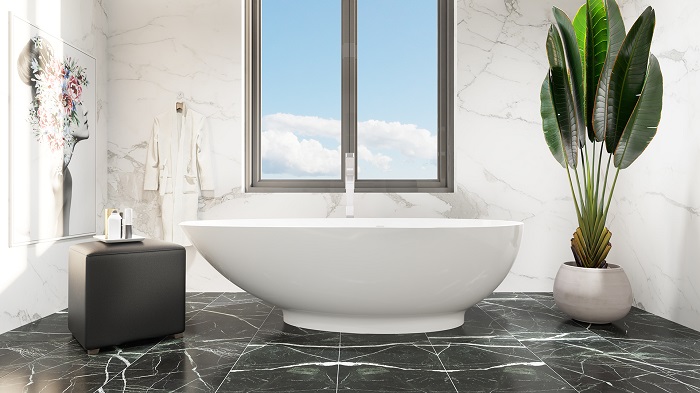When it comes to designing a bathroom that combines both functionality and aesthetic appeal, choosing the best size for a freestanding tub is a crucial decision. Freestanding bathtubs have surged in popularity, largely due to their sleek design and the luxurious, spa-like atmosphere they bring to any bathroom space. Whether you are renovating a spacious master bathroom or working with limited bathroom space, understanding freestanding tub sizes and how they fit into your room is essential for creating a relaxing and practical bathing area.
Measuring Your Space: The First Step
Before diving into the wide range of freestanding tubs available on the market, the first step is to carefully measure the available space in your bathroom. This simple but vital action will help you narrow down your options and avoid selecting a tub size that won’t fit comfortably. Freestanding tubs typically range in length from 55 inches to 72 inches, but the best size for your bathroom depends on the overall dimensions of your room and how much space you want to dedicate to bathing.
A useful rule of thumb is to allow at least one foot of clearance between the bathtub base and any walls or other fixtures. This spacing ensures easy access around the tub for cleaning and maintenance while maintaining a balanced look. For example, if your bathroom floor area is limited, selecting smaller freestanding tubs that still offer ample space for bathing can be a smart choice.
Considering Tub Size and User Needs
Another important factor in selecting the best size for a freestanding tub is understanding who will be using it most often. For single-person bathing, a smaller tub with a length around 55 inches might suffice, especially in smaller bathrooms. However, if you plan on enjoying the tub with a partner, opting for a larger, double-ended freestanding tub with a center drain is ideal. These larger tubs typically provide full body immersion for two bathers and are designed with drains positioned in the center or opposite end to maximize comfort and water flow.
The height of the bathtub also plays a role, especially if you will be bathing children. Freestanding tubs usually range from 15 to 22 inches in height. Lower profile tubs make it easier to bathe kids safely, while deeper, taller tubs can offer a more luxurious soaking experience for adults.
Materials and Style Impact on Size and Installation
Freestanding tubs come in various materials such as acrylic, cast iron, and composite blends. Cast iron tubs are known for their durability and heat retention, contributing to a spa-like atmosphere by keeping hot water warm longer. However, cast iron tubs tend to be heavier and may require reinforced bathroom floors, especially on upper levels. Acrylic tubs, on the other hand, are lighter and easier to install but may not retain heat as well.
The style of the tub—whether it’s a classic slipper design, double-ended, or pedestal—also influences the size and installation requirements. For example, double-ended tubs often have symmetrical shapes with faucets installed at the center, while slipper tubs feature a raised back for reclining. When planning installation, consider the location of plumbing and faucet hookups, as well as doorways and access points in your bathroom to ensure the tub can be brought in and installed without hassle.
Creating a Spa-Like Bathroom with the Right Tub Size
Choosing the right freestanding tub size allows you to create a luxurious focal point in your bathroom. Large tubs can fill spacious rooms elegantly, while small freestanding tubs can maximize functionality in more limited space without sacrificing style. In both cases, the tub becomes a centerpiece that invites relaxation and rejuvenation.
For bathrooms with limited space, alcove tubs or smaller tubs may be more practical, but freestanding tubs offer a unique aesthetic appeal that can transform even a modest bathroom into a stylish retreat. Remember to consider water capacity and your water heater’s ability to fill larger tubs efficiently, as bigger tubs typically require more water and longer fill times.
A Complete Guide to Freestanding Tub Sizes
To assist in your decision-making process, many manufacturers and retailers provide detailed guides on freestanding tub sizes, installation requirements, and style options. These resources can help you visualize how different tub sizes will fit into your bathroom and accommodate your lifestyle.
For example, a freestanding tub size guide can show you various length, width, and height options, helping you choose a size that balances comfort, space, and aesthetic appeal. Whether you prefer the timeless elegance of cast iron tubs or the modern sleekness of acrylic tubs, understanding the dimensions and installation needs is key to achieving a successful bathroom design.
In summary, the best size for a freestanding tub depends on your bathroom’s available space, who will be using the tub, and your desired style and functionality. By measuring your bathroom carefully, considering user needs, and exploring the range of freestanding tub sizes and materials, you can select a tub that not only fits perfectly but also enhances your bathroom’s luxury and relaxation. Whether you opt for a small freestanding tub for a cozy bathroom or a large double-ended tub for a spacious spa-like experience, the right size tub will transform your bathroom into a stunning and comfortable retreat.

